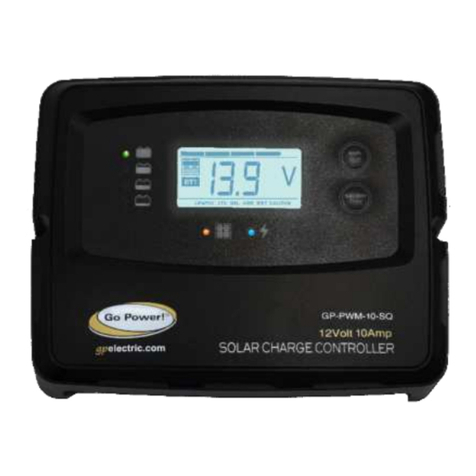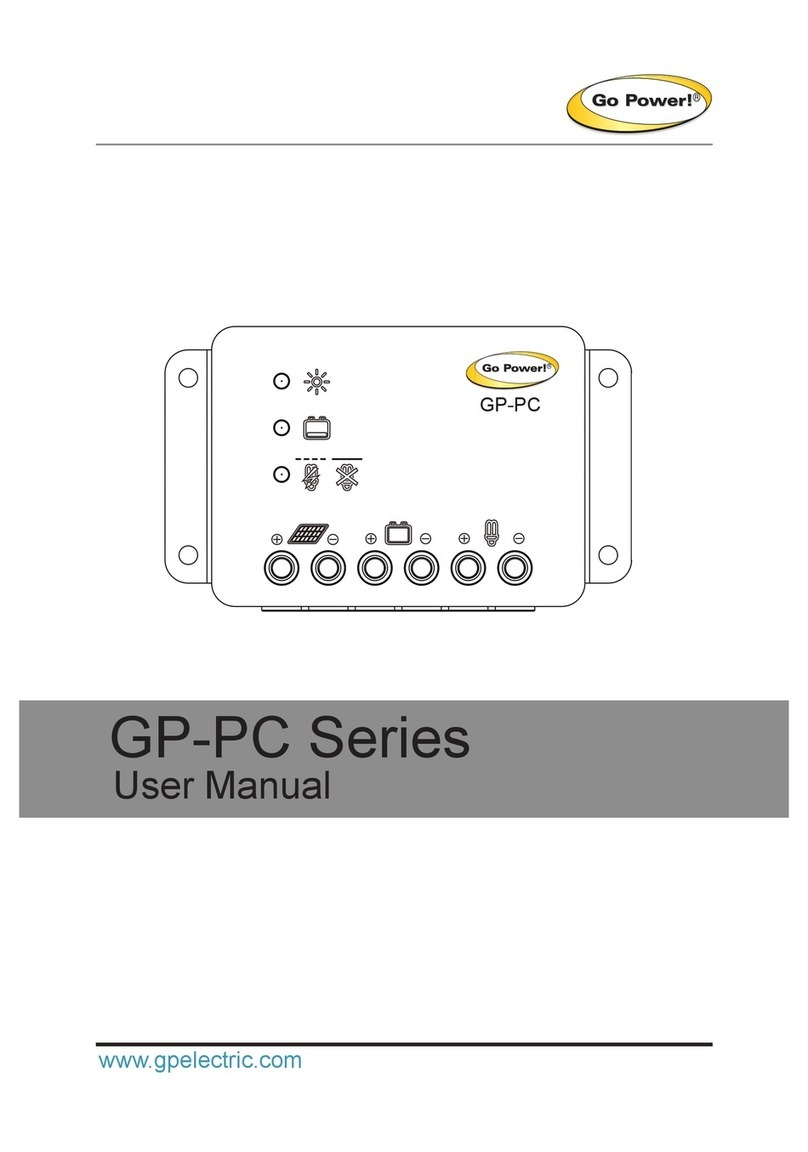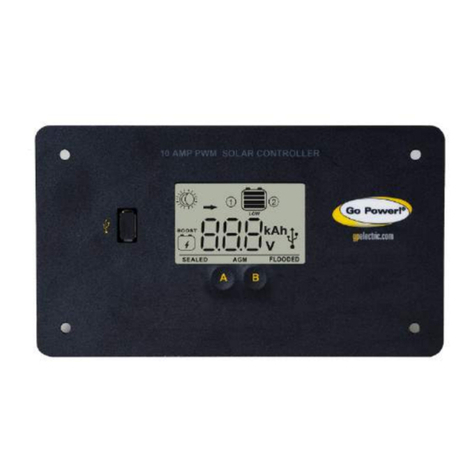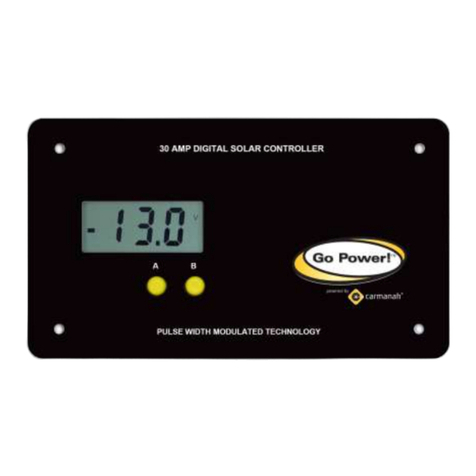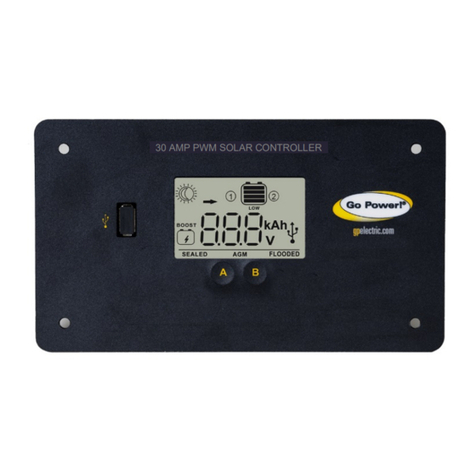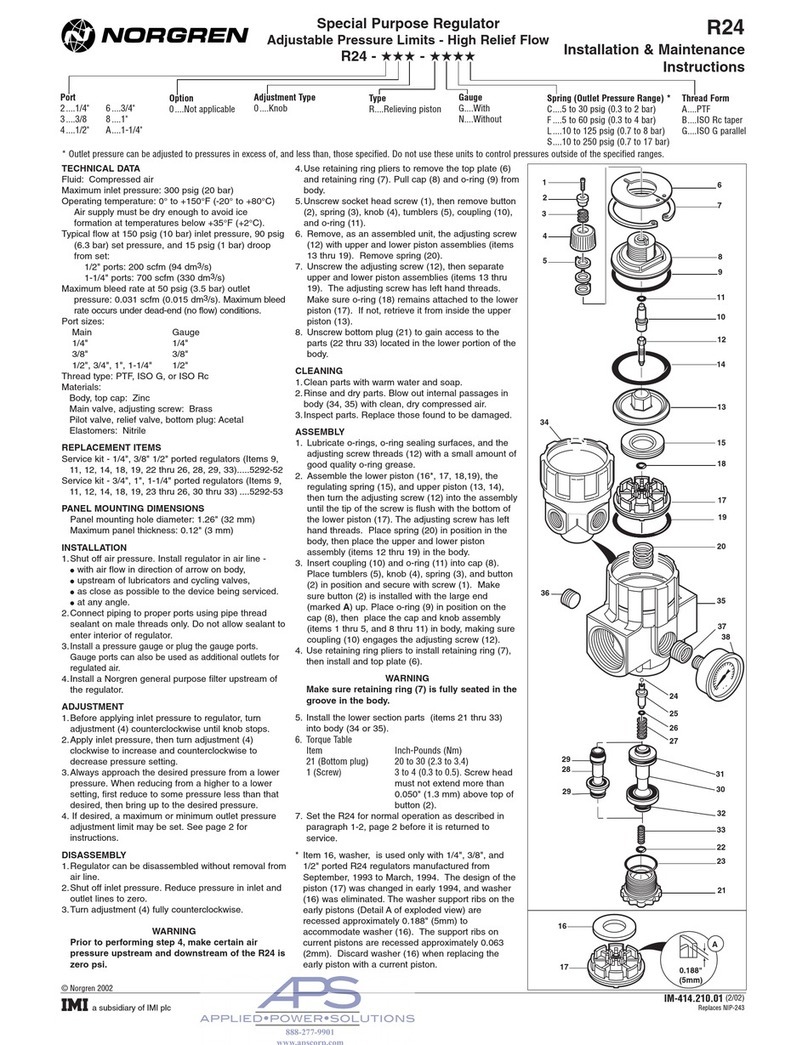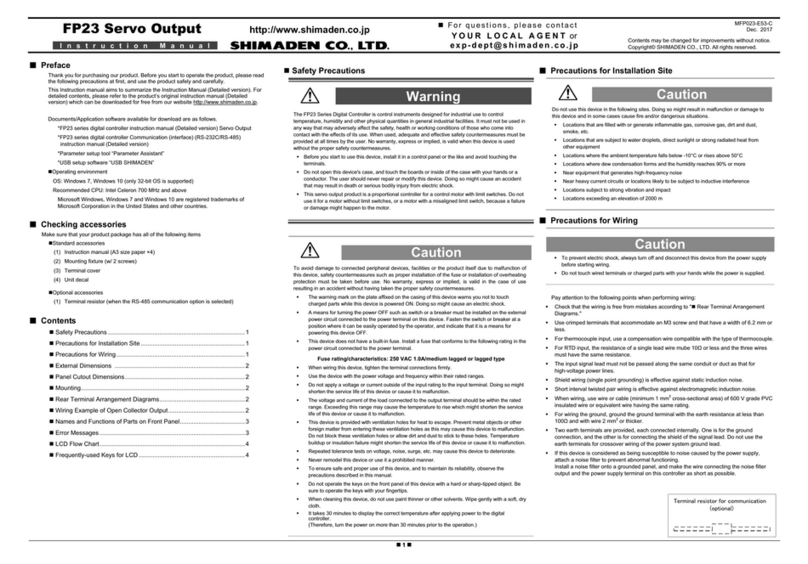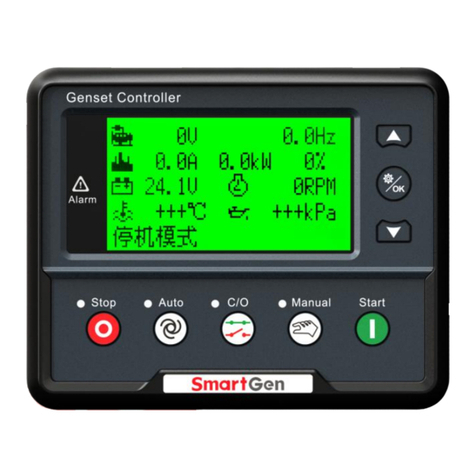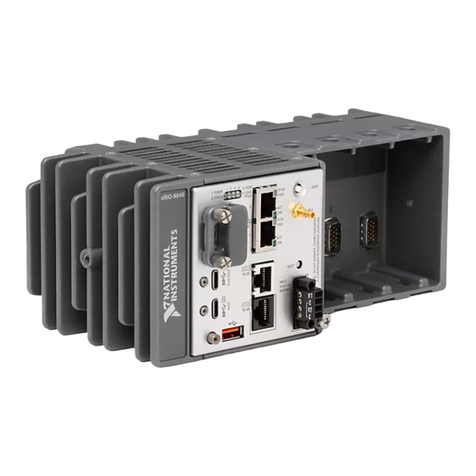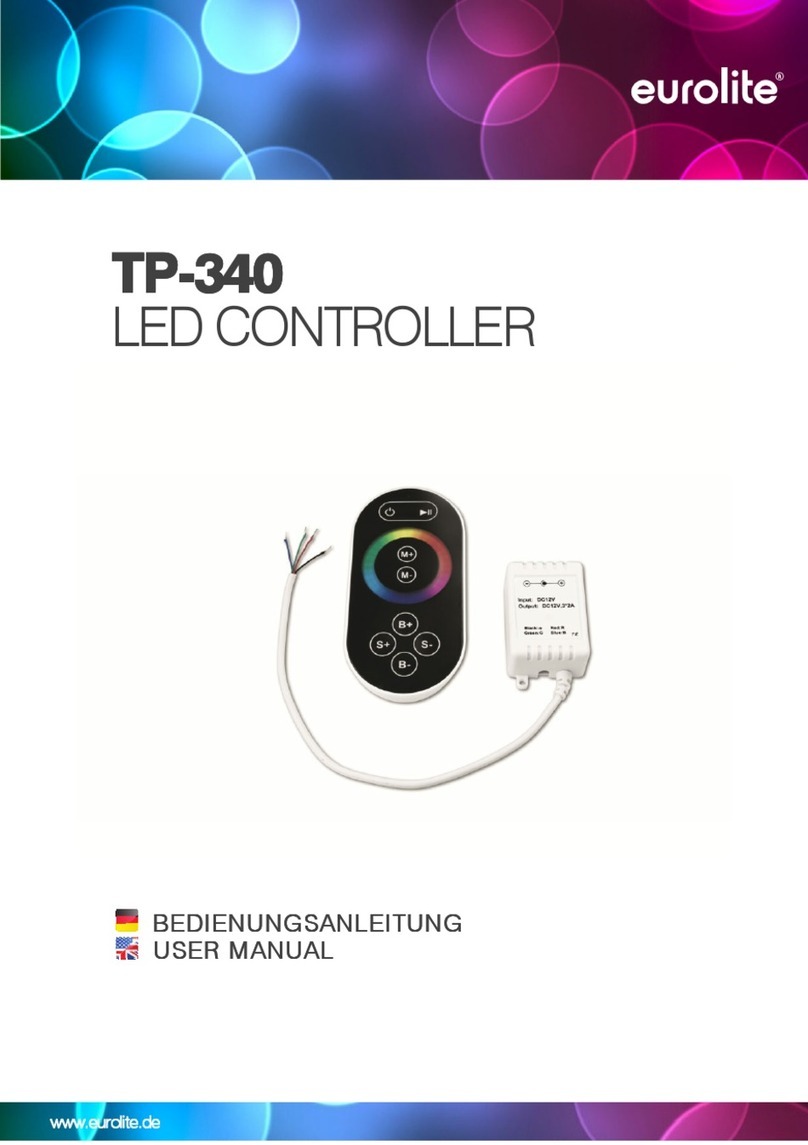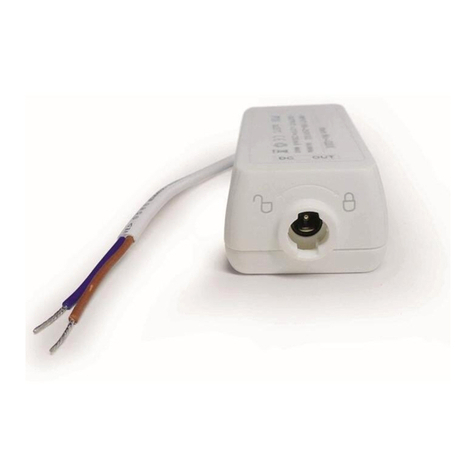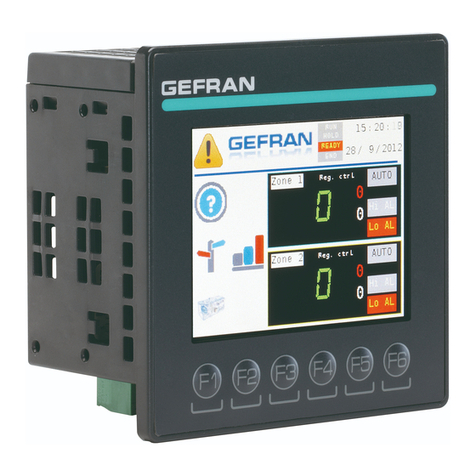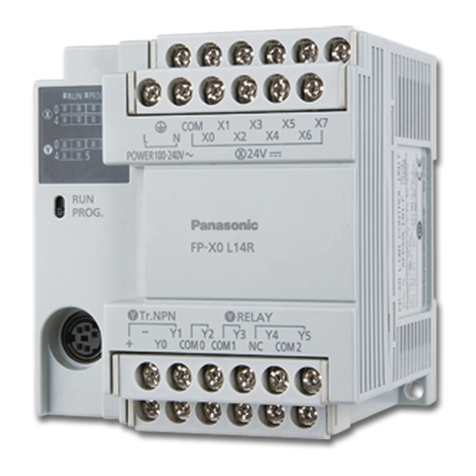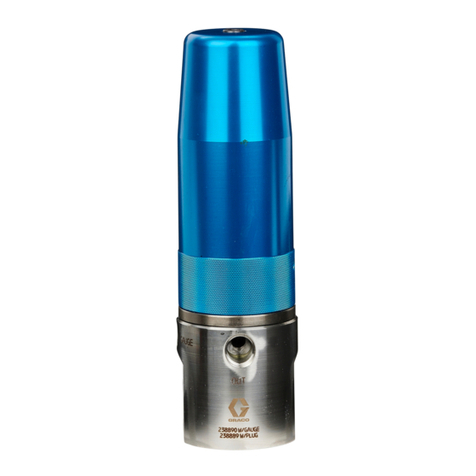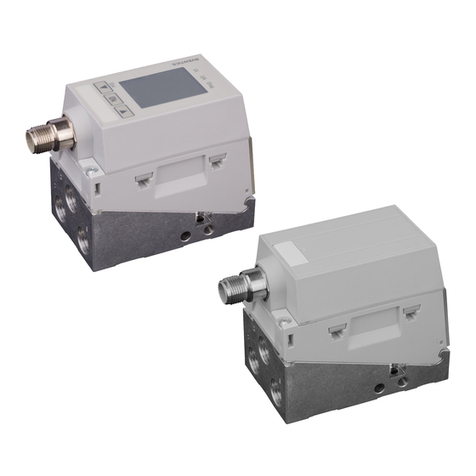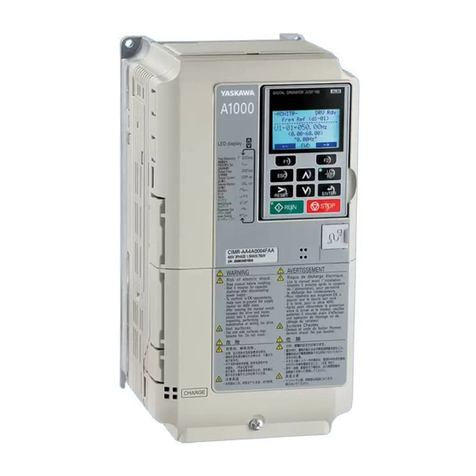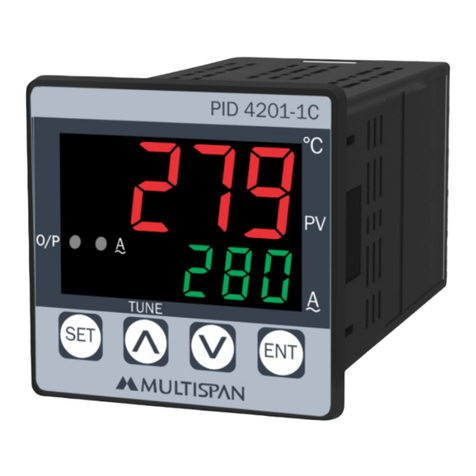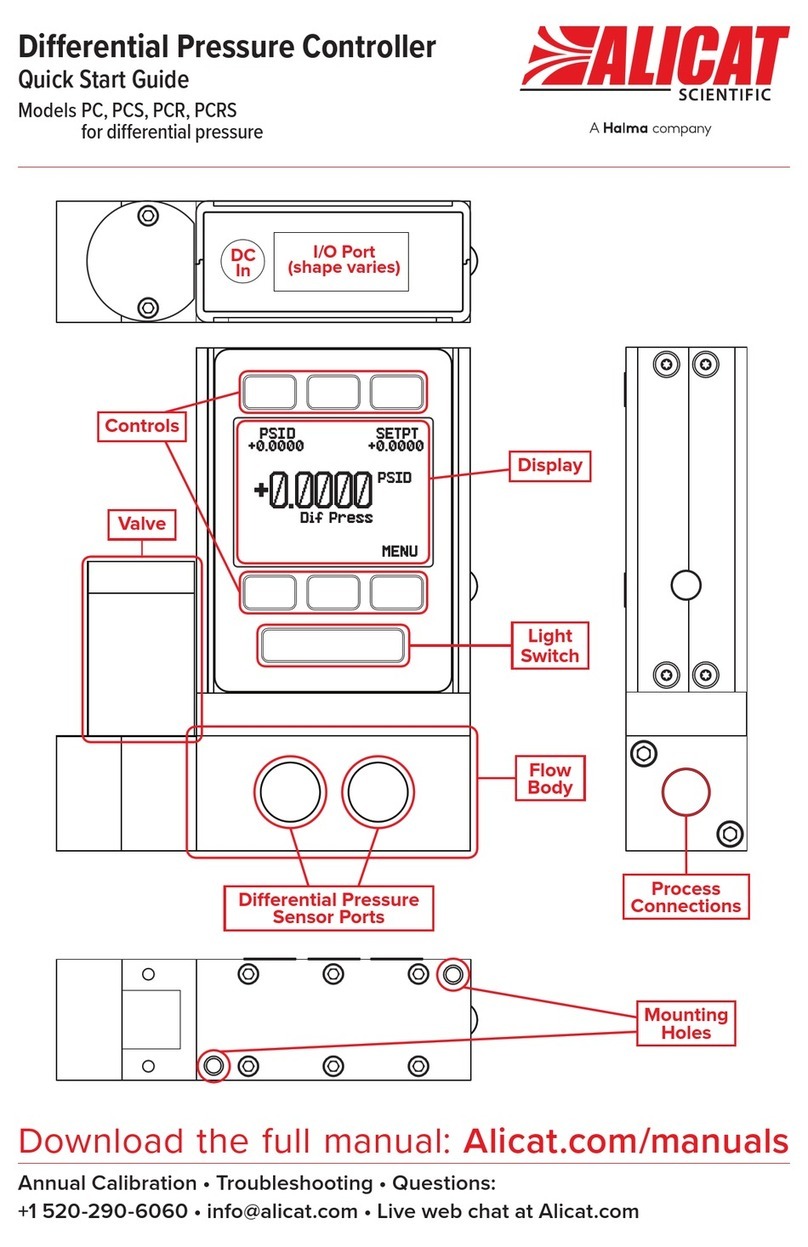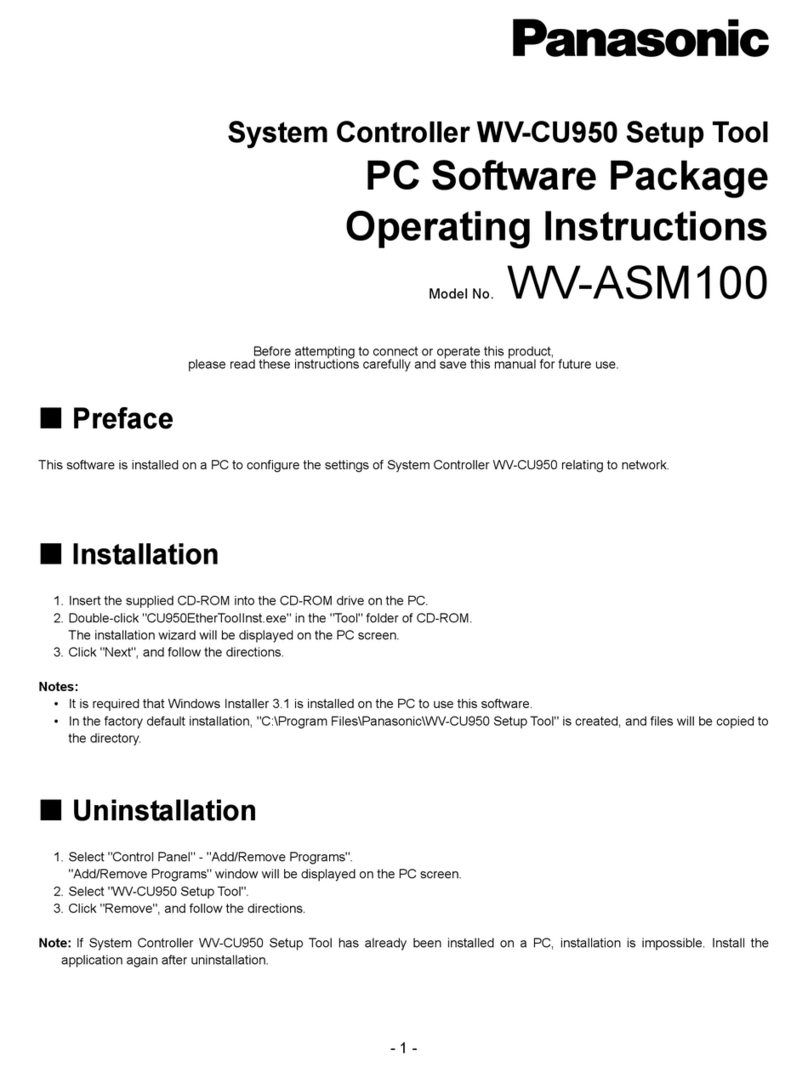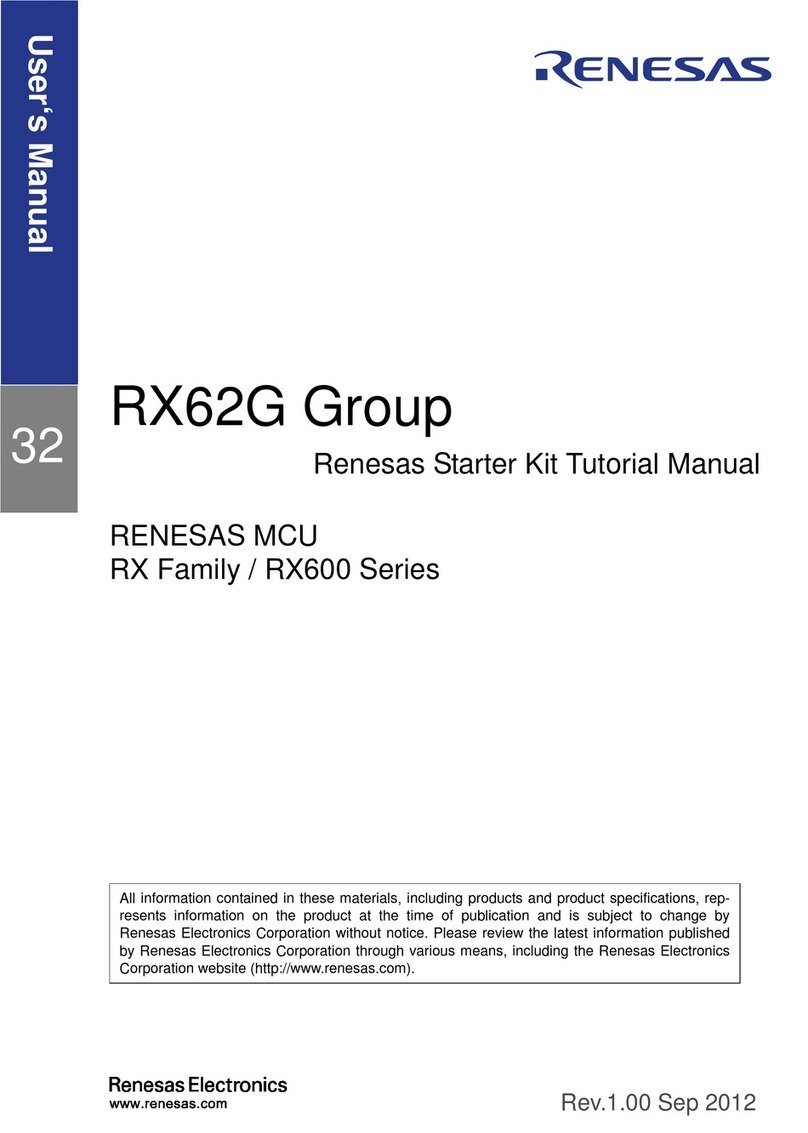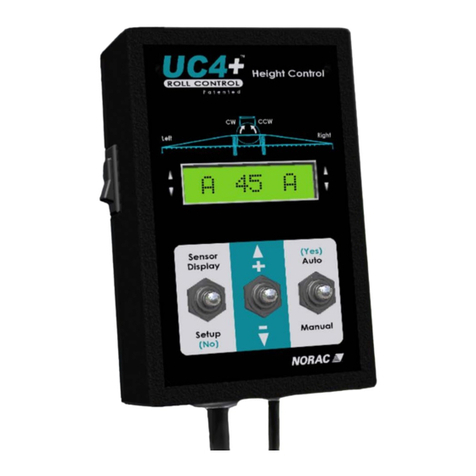Go Power GP-PWM-30-SB User manual

GP-PWM-30-SB
________________________________________________________________________
© 2019 Go Power!
GP-PWM-30-SB
User Manual
30 AMP PWM SOLAR CONTROLLER

GP-PWM-30-SB
2
© 2019 Go Power!
Contents
1.0 Installation Overview 3
1.1 Introduction 3
1.2 System Voltage and Current 3
1.3 Battery Type 3
1.4 Low Voltage Disconnect Function (USB Port) 4
1.5 Regulatory Information 4
1.6 Specifications 4
2.0 IMPORTANT SAFETY INSTRUCTIONS 6
3.0 Tools and Materials Needed 7
4.0 Choosing a Location 7
5.0 Installation Instructions 7
6.0 Wiring Diagram 10
7.0 Operating Instructions 11
7.1 Power Up 11
7.2 Setting the Battery Charging Profile 12
7.3 Battery Charging Profile Chart 12
7.4 Viewing the Controller Display Information 13
7.5 Resetting the ampere hours charged 16
7.6 Errors 16
8.0 Display Symbols 17
9.0 USB Charging 19
10.0 Frequently Asked Questions (FAQs) 19
11.0 Troubleshooting Problems 21
11.1 Problems with the Display 21
11.2 Problems with Voltage 22
11.3 Problems with Current 23
12.0 Limited Warranty 25
12.1 Repair and Return Information 25
13.0 Installation Template 25

GP-PWM-30-SB
3
© 2019 Go Power!
1.0 Installation Overview
1.1 Introduction
A Solar Controller (or Charge Controller / Regulator) is an essential
component of your photovoltaic solar system. The Controller maintains
the life of the battery by protecting it from overcharging. When your
battery has reached a 100% state of charge, the Controller prevents
overcharging by limiting the current flowing into the batteries from your
solar array.
The GP-PWM-30-SB uses Pulse Width Modulation (PWM) technology
and a unique four stage charging system that includes an optional
equalize setting to charge and protect your battery bank. The GP-PWM-
30-SB features an LCD digital display that shows the charge current of
the solar array, battery voltage and battery state of charge.
1.2 System Voltage and Current
The GP-PWM-30-SB is intended for use at 12 VDC nominal system
voltage and is rated for a maximum continuous DC input current of 37.5A
and input voltage of 35VDC.
Per the National Electric Code (NEC) article 690.7 and 690.8, PV module
nameplate ratings at Standard Test Conditions (STC) must be multiplied
by required values (typically 1.25 for both voltage and current) to obtain
the true voltage and continuous current available from the module.
Applying the NEC factors, the maximum allowable nameplate PV Panel
rated Isc is 30A (30A x 1.25 = 37.5A), and the maximum voltage, Voc is
28VDC (28VDC x 1.25 = 35VDC).
The voltage and current ratings of all equipment connected to PV panels
must be capable of accepting the voltage and current levels available
from PV panels installed in the field.
1.3 Battery Type
The GP-PWM-30-SB is suitable for use with lead acid batteries (vented,
GEL, or AGM) as well as some lithium iron phosphate (LiFePO4)
batteries that are supplied with a Battery Management System (BMS).

GP-PWM-30-SB
4
© 2019 Go Power!
1.4 Low Voltage Disconnect Function (USB Port)
To protect the battery against over-discharge this function automatically
switches off the USB output port when battery voltage is lower than 11.0
VDC. As soon as the battery reaches a voltage of 12.8 VDC the USB
output port is switched on again.
1.5 Regulatory Information
1.6 Specifications
Description
Value
Dimensions
(H x W x D):
149 x 98 x 32 mm
5.87 x 3.86 x 1.26 in
Weight: 260 g / 9.2 oz
Maximum Wire Gauge:
#4 AWG
Warranty: 5 years
•PWM Charging
•4 Battery Charging
Profiles
•4-Stage Charging
•Monthly Equalize
Option
•Displays Charging
Current, Battery
Voltage, Battery State
of Charge, and Amp
Hours Charged Since
Last Reset
•Reverse Polarity
Protected
Model
GP-PWM-30-SB
Nominal System Voltage 12 VDC
Range of Battery Input
Voltage
9.0 – 15.5 VDC
Maximum Solar Continuous
DC Charge Current Input
37.5 VDC
Charging Output DC Voltage
Range
9.0 – 14.9 VDC
Maximum Solar DC Input
Voltage
35 VDC
Maximum Series Fuse or
Circuit Breaker Solar/Battery
15 A
Operating Consumption
(Display backlight on)
15 mA
Operating Consumption
(Display backlight off)
6 mA
Battery Types Supported Vented and Sealed Lead Acid
(GEL, AGM, Flooded, Lithium
(LFP), etc.)

GP-PWM-30-SB
5
© 2019 Go Power!
Bulk/Absorption Voltage
(Sealed/GEL, AGM, Flooded)
14.1/14.4/14.4 VDC
(25°C / 77°F), 30min / Day
or 2hr if battery voltage < 12.3
VDC
•Temperature
Compensated
•RoHS Compliant,
Environmentally Safe
•Accepts up to 510 or
540 Watts (for the
190watt Extreme) of
Solar at 12 Volts
Absorption Voltage (LiFePO4) 14.4V
30min / Day
Float Voltage (Sealed/Gel,
AGM, Flooded)
13.7V (25°C / 77°F)
Float Voltage (LiFePO4)
14.0V
Equalization Voltage
(Sealed only)
14.9V (25°C / 77°F),
2h / 28 Days
or if battery voltage < 12.1 VDC
Temperature Compensation
(Sealed/Gel, AGM, Flooded)
- 24mV/ºC / -13mV/ºF
USB charger
5V, 1500mA
Low Voltage Disconnect
(USB)
11.0 VDC
Reconnects once battery reaches:
12.8V for Sealed/Gel, AGM,
Flooded
12.2V for LiFePO
4
Operating Temperature
- 40 to 85°C / - 40 to 185°F
Display Operating
Temperature
- 10 to 55°C / 14 to 131°F
Humidity
99% N.C.
Protection Battery Reverse Polarity, Solar
Array Reverse Polarity, Over
Temperature, PV Short Circuit,
Over Current

GP-PWM-30-SB
6
© 2019 Go Power!
2.0 IMPORTANT SAFETY INSTRUCTIONS
SAVE THESE INSTRUCTIONS
THIS MANUAL CONTAINS IMPORTANT INSTRUCTIONS FOR MODEL
GP-PWM-30-SB THAT SHOULD BE FOLLOWED DURING
INSTALLATION AND MAINTENANCE OF THE GP-PWM-30-SB.
Disconnect all
power sources
Electricity can be very dangerous. Installation
should be performed only by a licensed
electrician or qualified personnel.
Battery and
wiring safety
Observe all safety precautions of the battery
manufacturer when handling or working
around batteries. When charging, batteries
produce hydrogen gas, which is highly
explosive.
Wiring
connections
Ensure all connections are tight and secure.
Loose connections may generate sparks and
heat. Be sure to check connections one week
after installation to ensure they are still tight.
Work safely
Wear protective eyewear and appropriate
clothing during installation. Use extreme
caution when working with electricity and
when handling and working around batteries.
Observe
correct polarity
Reverse polarity of the battery terminals and
array will cause the controller to give a
warning tone. The controller will not function
unless battery terminals are connected to a
battery with proper polarity. Failure to correct
this fault could damage the controller.
Do not exceed
the GP-PWM-
30-SB Amp
current and
max voltage
ratings
The maximum current of the solar system is
the sum of parallel-connected PV module–
rated short circuit Currents (Isc) multiplied by
1.25. The resulting system current is not to
exceed 37.5A. If your solar system exceeds
this value, contact your dealer for a suitable
controller alternative.
Do not exceed
the GP-PWM-
30-SB max
voltage ratings
The maximum voltage of the array is the sum
of the PV module–rated open-circuit voltage of
the series connected modules multiplied by
1.25 (or by a value from NEC 690.7 provided
in Table 690.7 A). The resulting voltage is not
to exceed 35V. If your solar system exceeds
this value, contact your dealer for a suitable
controller alternative.

GP-PWM-30-SB
7
© 2019 Go Power!
3.0 Tools and Materials Needed
•Flathead Screwdriver (for wire terminals)
•Phillips Screwdriver (for mounting screws)
•Wire Stripper/Cutter
If the GP-PWM-30-SB Controller was purchased with a
Go Power! Solar Power Kit, then UV resistant wire is
included. For instructions regarding the Go Power! Solar
Power Kit installation, please refer to the Installation
Guide provided with the Kit.
4.0 Choosing a Location
The GP-PWM-30-SB is designed to be mounted flush against a wall, out
of the way but easily visible.
The GP-PWM-30-SB should be:
•Mounted as close to the battery as possible
•Mounted on a vertical surface to optimize cooling of the unit
•Indoors, protected from the weather
In an RV, the most common controller location is above the refrigerator.
The wire from the solar array most commonly enters the RV through the
fridge vent on the roof or by using the Go Power! Cable Entry Plate (sold
separately) that allows installers to run wires through any part of the roof.
PV connections should connect directly to the controller. Positive and
negative battery connections must connect directly from the controller to
the batteries. Use of a positive or negative distribution bus is allowed
between the controller and battery as long as it is properly sized,
electrically safe and an adequate wire size is maintained.
5.0 Installation Instructions
1. Prepare for mounting. Use the template provided on page 27
to mark the four mounting holes and the cutting line for flush
mounting your controller.

GP-PWM-30-SB
8
© 2019 Go Power!
2. Complete the installation of the solar modules. If this
GP-PWM-30-SB was purchased as part of a Go Power! Solar
Power Kit, follow the Installation Guide provided. Otherwise,
follow manufacturer’s instructions for solar module mounting and
wiring.
Do not exceed
the GP-PWM-
30-SB Max
current ratings
The maximum current of the solar system is
the sum of parallel-connected PV module–
rated short circuit Currents (Isc) multiplied by
1.25. The resulting system current is not to
exceed 37.5A. If your solar system exceeds
this value, contact your dealer for a suitable
controller alternative.
Do not exceed
the GP-PWM-
30-SB Max
voltage ratings
The maximum voltage of the array is the sum
of the PV module–rated open-circuit voltage of
the series connected modules multiplied by
1.25 (or by a value from NEC 690.7 provided
in Table 690.7 A). The resulting voltage is not
to exceed 35V. If your solar system exceeds
this value, contact your dealer for a suitable
controller alternative.
3. Select wire type and gauge. If this GP-PWM-30-SB was
purchased as part of a Go Power! Solar Power Kit, appropriate
wire type, gauge, and length is provided. Please continue to
Section 6, “Operating Instructions.” If the GP-PWM-30-SB was
purchased separately, follow the instructions included here.
Wire type is recommended to be a stranded copper UV-resistant wire.
Wire fatigue and the likelihood of a loose connection are greatly reduced
in stranded wire compared to solid wire. Wire gauge should be able to
sustain rated current and minimize voltage drop.
Wire Strip Length
Strip wires to a length of approximately 3/8 in (9 mm, as per strip gauge).
Suggested Minimum Wire Gauge
(Cable length 25 ft. max. from solar array to battery bank)
80-Watt Solar Module
#10 Wire Gauge
100-Watt Solar Module
#10 Wire Gauge
160-Watt Solar Module
#10 Wire Gauge
170-Watt Solar Module
#10 Wire Gauge
190-Watt Solar Module
#10 Wire Gauge

GP-PWM-30-SB
9
© 2019 Go Power!
IMPORTANT: Identify the polarity (positive and negative) on the cable
used for the battery and solar module. Use colored wires or mark the
wire ends with tags. Although the GP-PWM-30-SB is protected, a
reverse polarity contact may damage the unit.
Wiring the GP-PWM-30-SB.Wire the GP-PWM-30-SB according to the
wiring schematic in Section 6. Run wires from the solar array and the
batteries to the location of the GP-PWM-30-SB. Keep the solar array
covered with an opaque material until all wiring is completed.
IMPORTANT: All wiring must be in accordance to National Electrical
Code, ANSI/NFPA 70. Always use appropriate circuit protection on any
conductor attached to a battery.
4. Connect the battery wiring to the controller first and then
connect the battery wiring to the battery.
5. Torque all terminal screws per the following:
Stranded Copper 90°C Wire
Wire Size AWG
Rated Torque (in-lbs)
14
20
12
20
10
20
With battery power attached, the controller should power up and display
information. Connect the solar wiring to the controller and remove the
opaque material from the solar array. The negative solar array and
battery wiring must be connected directly to the controller for proper
operation. Do not connect the negative solar array or negative battery
controller wiring to the chassis of the vehicle.
6. Mounting the GP-PWM-30-SB.Mount the GP-PWM-30-SB to
the wall using the included four mounting screws.
IMPORTANT: You must set the battery type on the GP-PWM-30-SB
before you begin to use the controller (follow steps in Section 7). The
default battery setting is for AGM batteries.

GP-PWM-30-SB
10
© 2019 Go Power!
Congratulations, your GP-PWM-30-SB should now be operational. If the
battery power is low and the solar array is producing power, your battery
should begin to charge.
7. Re-torque: After 30 days of operation, re-torque all terminal
screws to ensure the wires are properly secured to the controller.
WARNING: This unit is not provided with a GFDI device. This
charge controller must be used with an external GFDI device as
required by Article 690 of the National Electric Code for the
installation location.
6.0 Wiring Diagram
IMPORTANT: This diagram is valid only for version 1.5 and newer.
Version 1.4 and older have different terminal locations.
The GP-PWM-30-SB Maximum 37.5A rating is based on a 30 amp total
maximum short circuit current rating (Isc) from the parallel solar modules
nameplate ratings. The National Electric Code specifies the PV
equipment/system rating to be 125% of the maximum Isc from the PV
module nameplate ratings (1.25 times 30 = 37.5A). Use the wiring
diagram (below) to connect your battery to the battery terminals on the
solar controller. First, connect the battery to the controller, and then
connect the solar panel to the controller.
The fuse or breaker used should be no larger than 50 amps.
The controller will not work unless there is a battery
connected to the battery terminals with at least 9V.
WARNING: When the photovoltaic (solar) array is exposed to
light, it supplies a dc voltage to this equipment

GP-PWM-30-SB
11
© 2019 Go Power!
7.0 Operating Instructions
7.1 Power Up
When the GP-PWM-30-SB is connected to the battery, the controller will
go into Power Up mode.
Icons Displayed: All segments of the numerical display; backlight blinks.
Depending on the battery voltage when the GP-PWM-30-SB Power Up
occurs, the controller may do a Boost Charge or quickly go into Float
Charge. The Charging Profile selected will commence the following day
after a Power Up (refer to the Charging Profile Chart on page 11 for
more details).

GP-PWM-30-SB
12
© 2019 Go Power!
7.2 Setting the Battery Charging Profile
To select the battery charging profile, press and hold the B Button. This
will cause the current battery type to flash.
Then, press the B Button to toggle through the profile options:
Sealed/Gel, AGM/Lithium (LFP) or Flooded.
To confirm the battery profile, press and hold the A Button for 3
seconds.
Non-volatile memory: Any settings made on the GP-PWM-30-SB will
be saved even when the power has been disconnected from the
controller.
Refer to the Battery Charge Profile Chart below for details on each
profile.
7.3 Battery Charging Profile Chart
Battery Type
SEALED
/GEL AGM FLOODED LFP
Float Charge @ 25°C:
13.7 VDC (+/- 0.1V)
N/A
Bulk/Absorption Charge @
25°C:
Set to 30 minutes every
morning. Applied for 2 hours if
the battery voltage drops
below 12.3 volts.
14.1 VDC
(+/- 0.1V)
14.4 VDC
(+/- 0.1V)
14.4 VDC
(+/- 0.1V) N/A

GP-PWM-30-SB
13
© 2019 Go Power!
If PV power is insufficient or too many loads are drawing
power from the battery, the controller will not be able to
charge the battery to the target charging voltage.
Auto Equalize: The GP-PWM-30-SB has an automatic equalize feature
that will charge and recondition your batteries at least once a month at a
higher voltage to ensure that any excess sulfation is removed.
This mode will not be entered unless you are using a
flooded battery.
7.4 Viewing the Controller Display Information
To toggle between Battery Voltage, PV Charging Current, Battery State
of Charge (SOC), and ampere hours charged since last reset, press the
B Button.
Equalization Charge @
25°C:
Applied for 2 hours every 28
days and if the battery voltage
drops below 12.1 volts.
N/A N/A 14.9 VDC
(+/-0.1V) N/A
Absorption Charge voltage
for LiFePO4:
Set to 30 minutes every
morning.
N/A 14.4 VDC
Float Charge voltage for
LiFePO4:
N/A 14.0 VDC
Temperature Compensation:
-24mV/K
None
If a charging cycle is unable to complete in a single day, it will continue the
following day.
The terms SEALED/GEL, AGM, LFP (Lithium) and FLOODED are generic
battery designations. Choose the charging profile that works best with your
battery manufacturer’s recommendations.

GP-PWM-30-SB
14
© 2019 Go Power!
Push the B Button to show the battery voltage.
Icons Displayed:Battery SOC, Volt Symbol (V)
Push the B Button to show the PV charging current.
Icons Displayed: Ampere Symbol (A), Battery SOC

GP-PWM-30-SB
15
© 2019 Go Power!
Push the B Button to show the battery state of charge (shown as a
percentage).
Icons Displayed: Battery SOC, Percent Symbol (%)
A value of 100% will only be displayed after a Boost or Equalize charge
completes.
Push the B Button to show the number of amp hours charged since the
last reset.
Icons Displayed: Amp hours charged, Amp hour symbol (Ah) or kiloamp
hour symbol (kAh)

GP-PWM-30-SB
16
© 2019 Go Power!
7.5 Resetting the ampere hours charged
To reset the count of ampere hours charged, toggle to the ampere hours
charged. Press and hold the A Button for 6 seconds to reset the counter
to zero.
7.6 Errors
Over Voltage
If the GP-PWM-30-SB experiences a battery over voltage (15.5V), the
controller will stop operating, and the display will begin to flash with all
icons. The controller will resume operating when the error is cleared.
Icons Displayed: All symbols

GP-PWM-30-SB
17
© 2019 Go Power!
Low Voltage
If the battery voltage reaches 11 volts, the battery SOC symbol will show
the text “LOW” beneath it. The controller will continue operating in this
condition, and will only stop operating if the voltage drops below 9 volts.
Icons Displayed: Battery SOC Symbol, LOW
8.0 Display Symbols
Symbol
Indicator For:
Day Time: PV Charge Current
Night Time
Battery Voltage
Battery State of Charge
SEALED
Sealed/Gel
AGM/LFP
AGM/LFP
FLOODED Flooded

GP-PWM-30-SB
18
© 2019 Go Power!
Other Symbols
USB charger on
(When charger is off, no symbol will show)
LOW
Battery voltage is lower than
11.0 VDC
Whole display will start to blink Battery voltage > 15.5 VDC
Battery State of Charge
Symbol
Battery Voltage
Shows only after full Boost
or Equalization Cycle
>= 12.6 VDC
>= 11.8 -12.6 VDC
> 11.0 -11.8 VDC
<= 11.0 VDC
100%
Shows only after full Boost
or Equalization Cycle
90% >= 12.8 VDC
= −11.0
1.8∗90% <12.8 VDC and > 11.0
VDC
0% <= 11.0 VDC

GP-PWM-30-SB
19
© 2019 Go Power!
9.0 USB Charging
The GP-PWM-30-SB offers a standard USB connector for delivering 5.0
VDC to small mobile appliances such as cell phones, tablets or small
music players. This charging port is capable of supplying up to 1500 mA
of current.
Remove the rubber cover of the USB terminal to access the terminal.
The USB charging port is always active when the USB symbol appears
on the display.
The controller disables the USB charger automatically if the battery
voltage drops below 11.0 VDC. If there is enough current from the PV
panel/array available to charge the Battery to above 12.8 VDC, the USB
terminal will be enabled again.
WARNING: Do not connect the charging device anywhere else! USB-
Negative contact is connected to battery negative.
10.0 Frequently Asked Questions (FAQs)
Before a problem is suspected with the system, read this section. There
are numerous events that may appear as problems but are in fact
perfectly normal. Please visit gpelectric.com for the most up-to-date
FAQs.
It seems like my flooded batteries are losing water over time.
Flooded batteries may need to have distilled water added periodically to
replace fluid loss during charging. Excessive water loss during a short
period of time indicates the possibility of overcharging or aging batteries.
When charging, my flooded batteries are emitting gas.
During charging, hydrogen gas is generated within the battery. The gas
bubbles stir the battery acid, allowing it to receive a fuller state of charge.
Important: Ensure batteries are in a well-ventilated space.

GP-PWM-30-SB
20
© 2019 Go Power!
My voltmeter shows a different reading than the GP-PWM-30-SB
display.
The meter value on the GP-PWM-30-SB display is an approximate
reading intended for indication purposes only. There is an approximate
0.1 volt inherent error present that may be accentuated when compared
with readings from another voltmeter.
There may be a slight difference between the battery voltage displayed
on the GP-PWM-30-SB display and the battery voltage measured at the
battery terminals. When troubleshooting using a voltmeter, check both
the battery voltage at the GP-PWM-30-SB controller terminals and
battery voltage at the battery terminals. If a difference of more than 0.5
volts is noted, this indicates a large voltage drop possibly caused by
loose connections, long wire runs, small wire gauge, faulty wiring, a
faulty voltmeter, or all the above. Consult the Suggested Minimum Wire
Gauge chart in Section 5 for wiring suggestions and check all
connections.
What causes a warning signal and when are the warnings
triggered?
Connection
Warning
Notes
LCD
Battery
reverse
polarity
“POL” on LCD
and constant
audible alarm
PV reverse
polarity
“POL” on LCD
and constant
audible alarm
Battery must be
connected with
correct polarity
Why does the battery SOC% never reach 100%?
A 100% value will only appear after a 30 min Boost at 14.4V or Equalize
charge has completed. The charge voltage must be maintained for an
extended period of time to replenish the energy in the battery bank back
to its rated capacity.
If the charge voltage cannot be maintained continuously, then the actual
time it takes to complete Boost or Equalize charging may take much
longer than 2 hours, even more than 1 day.
If loads are consuming more power than the solar panels can supply,
then the battery bank cannot be charged to 100%.
Other manuals for GP-PWM-30-SB
1
Table of contents
Other Go Power Controllers manuals
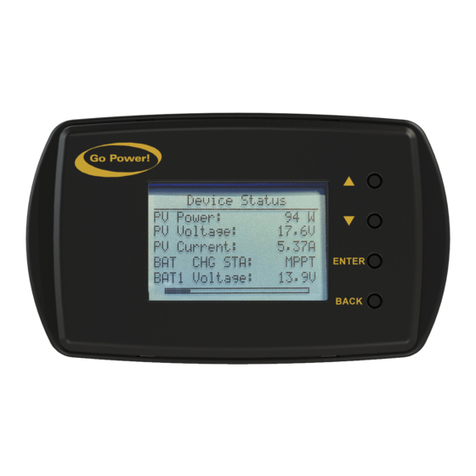
Go Power
Go Power GP-RVC-R User manual
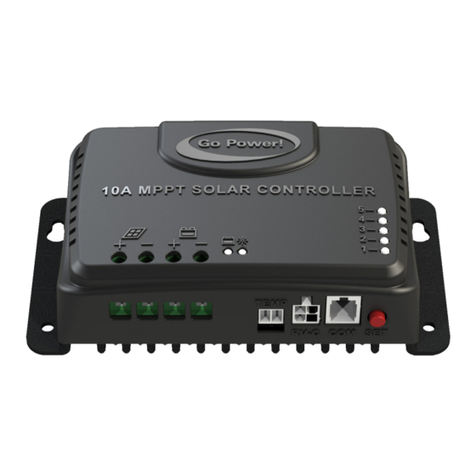
Go Power
Go Power 10 AMP RVC-MPPT User manual
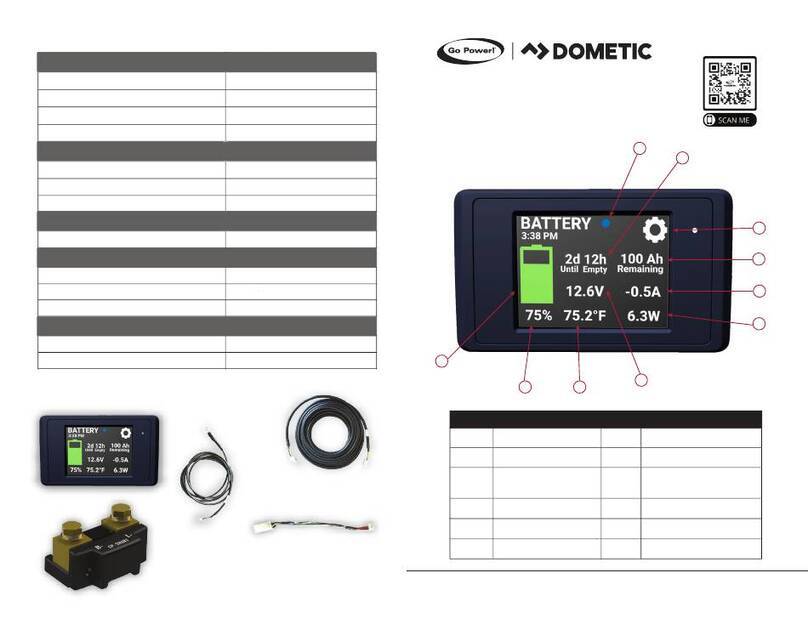
Go Power
Go Power DOMETIC GP-BMG User manual

Go Power
Go Power GP-PWM-10 User manual
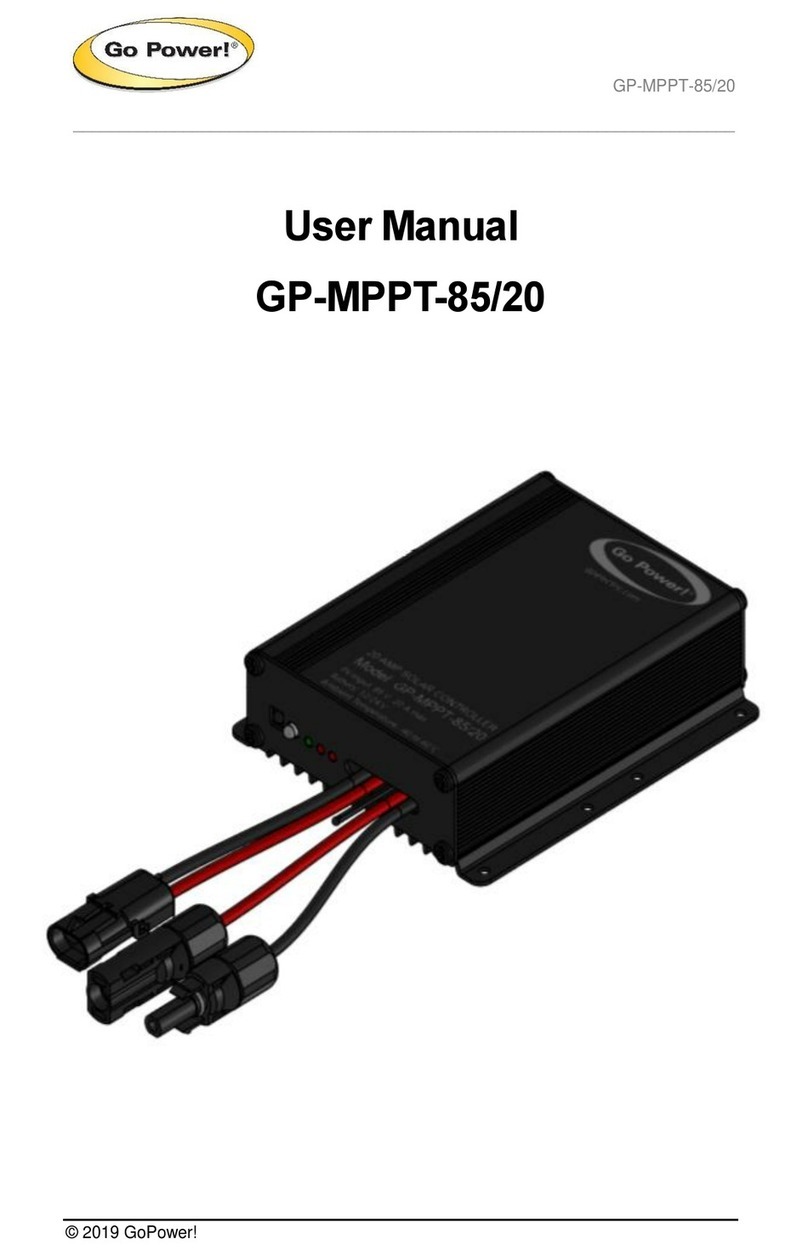
Go Power
Go Power GP-MPPT-85/20 User manual
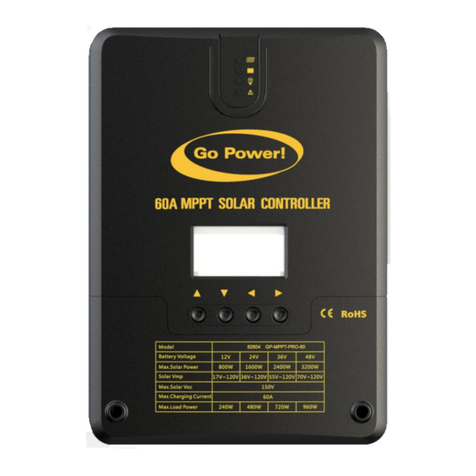
Go Power
Go Power MPPT-PRO Series User manual
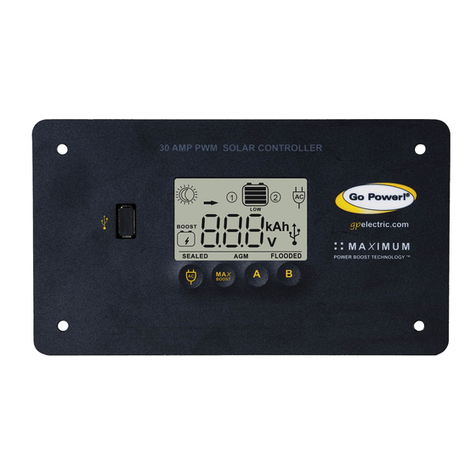
Go Power
Go Power GP-PWM-30-UL User manual
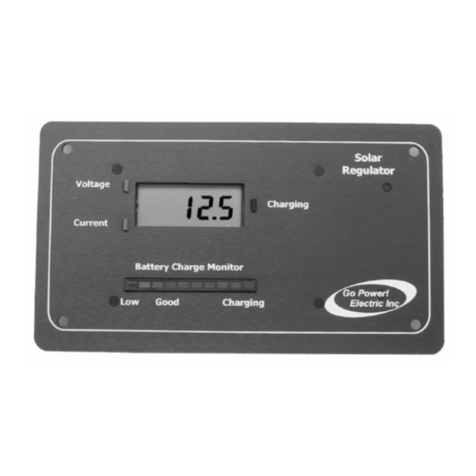
Go Power
Go Power GPR-25 User manual

Go Power
Go Power GP-DURALITE-100 User manual
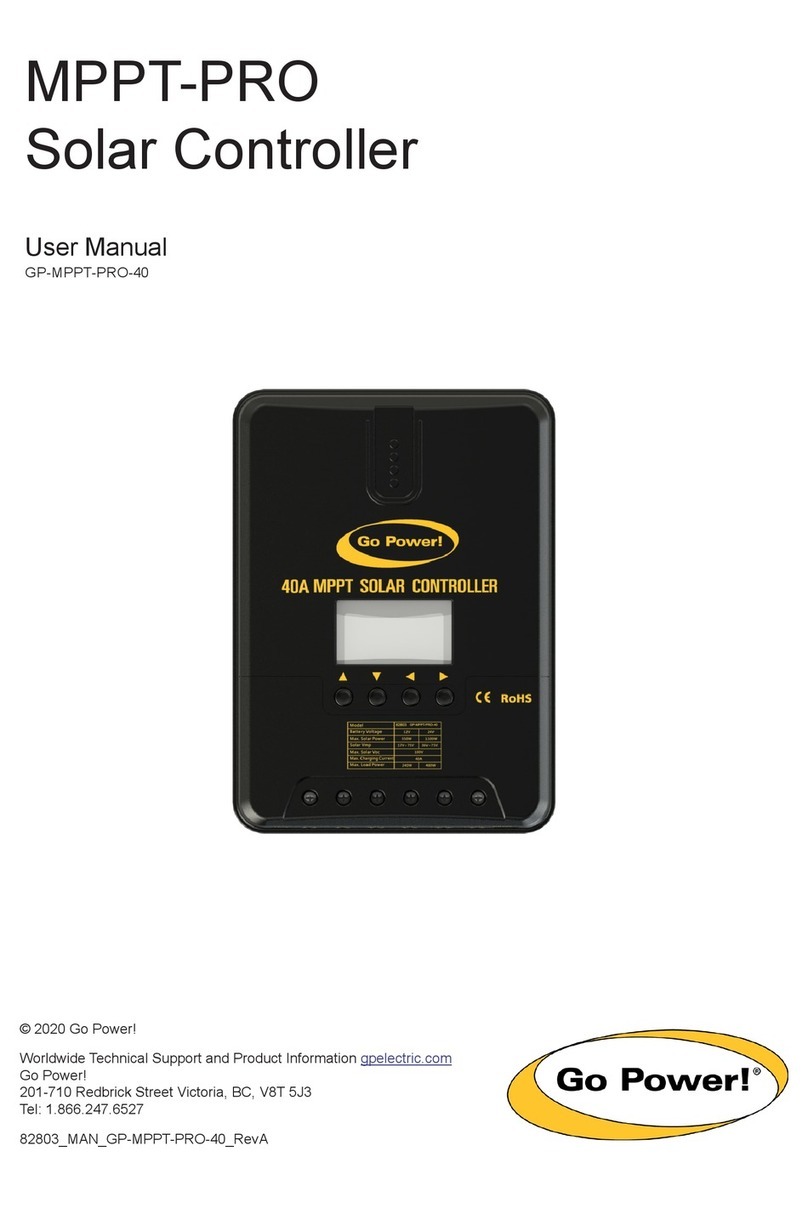
Go Power
Go Power MPPT-PRO User manual


